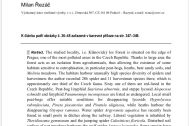Rok
2020Autoři
RNDr. Milan Řezáč, Ph.D.Druhy
Argyroneta aquatica (Clerck, 1757) VUDysdera hungarica Kulczyński, 1897 ES
Panamomops inconspicuus (Miller & Valešová, 1964) EN
Saaristoa abnormis (Blackwall, 1841) EN
Alopecosa schmidti (Hahn, 1835) EN
Arctosa leopardus (Sundevall, 1833) VU
Hygrolycosa rubrofasciata (Ohlert, 1865) VU
Pirata piscatorius (Clerck, 1757) VU
Piratula uliginosa (Thorell, 1856) VU
Nemastoma bidentatum sparsum (Gruber et Martens, 1968)
Oxyopes ramosus (Martini & Goeze, 1778) LC
Attulus floricola (C. L. Koch, 1837) LC
Theridiosoma gemmosum (L. Koch, 1877) LC
Synema globosum (Fabricius, 1775) LC
Obsah
The studied locality, i.e. Klánovický les Forest is situated on the edge of Prague, one of the most polluted areas in the Czech Republic. Thanks to large area the forest acts as an isolation from agrochemicals, thus allowing the existence of some habitats sensitive to eutrophisation, in particular peat-bogs, heaths, bare sandy soils, and Molinia meadows. The habitats harbour unusually high species diversity of spiders and harvestmen: the author recorded 286 spider and 11 harvestman species there, which is approximately one third of the Czech fauna. Sixty one of them are red-listed in the Czech Republic. Peat-bog linyphiid Saaristoa abnormis, and steppe lycosid Alopecosa schmidti and linyphiid Panamomops inconspicuus are listed as endangered. Local small peat-bogs offer suitable conditions for disappearing lycosids Hygrolycosa rubrofasciata, Pirata piscatorius and Piratula uliginosa, while heaths harbour the disappearing Oxyopes ramosus. Water spider Argyroneta aquatica has recently been found in small pools in ditches along the railway. Littoral vegetation is inhabited by Theridiosoma gemmosum and the jumping spider Calositticus floricola. Disturbed soil surface of wet meadows harbours the wolf spider Arctosa leopardus. Some species have recently appeared at the site, for example Dysdera hungarica, the harvestman Nemastoma bidentatum sparsum or the crab spider Synema globosum. The first two were probably introduced there by man, the latter probably expands due to climate change. The author suggests to keep these habitats without woody vegetation to protect local high species diversity there.



